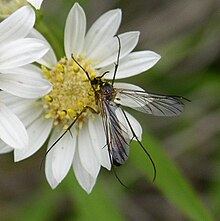| Keroplatidae Temporal range:
| |
|---|---|

| |
| Platyura marginata | |
| Scientific classification | |
| Domain: | Eukaryota |
| Kingdom: | Animalia |
| Phylum: | Arthropoda |
| Class: | Insecta |
| Order: | Diptera |
| Suborder: | Nematocera |
| Infraorder: | Bibionomorpha |
| Superfamily: | Sciaroidea |
| Family: | Keroplatidae Rondani, 1856 |
| Subfamilies | |
| Synonyms | |
| |
Keroplatidae is a family of small flies known as fungus gnats. About 950 species are described, but the true number of species is undoubtedly much higher. The long-beaked fungus gnats, formerly placed in a separate family Lygistorrhinidae, have been placed into Keroplatidae as subfamily Lygistorrhininae.[1] They are generally forest dwellers found in the damp habitats favoured by their host fungi.[2] They can also often be found in caves. Larvae both feed on fungi and are predatory - they can spin webs by secreting acid fluids, which they use to kill smaller invertebrates and capture spores. Some of the predatory larvae cannibalize pupa of their own species.[3] The family notably includes three genera containing bioluminescent larvae.
The fossil record of the family extends back into the Cretaceous, with the oldest named member, Lebanognoriste known from the Barremian aged Lebanese amber, other Cretaceous species are known from the Spanish, Burmese, Bezonnais, Taimyr and Canadian ambers.
Bioluminescence
[edit]Larvae in three genera of keroplatids are bioluminescent, and known as "glowworms", and they produce a blue-green light.[4] The larvae spin sticky webs to catch food. They are found in caves, overhangs, rock cavities, and other sheltered, wet areas. Despite the similarities in function and appearance, the bioluminescent systems of the three genera are not homologous and are believed to have evolved separately.[5][6][7]
- Genus Arachnocampa – around five species found only in New Zealand and Australia. The best-known member of the genus is the New Zealand glowworm, Arachnocampa luminosa. The larvae are predatory and use their lights to lure prey into their webs.[8]
- Genus Orfelia – sometimes known as "dismalites". Contains a single species, Orfelia fultoni, found only in North America. Like Arachnocampa spp., their larvae may use their lights to attract prey like springtails and other small insects, but their main food is fungal spores.[9]
- Genus Keroplatus – found in Eurasia. Unlike Arachnocampa and Orfelia, the larvae of Keroplatus feed only on fungal spores.[10] Their bioluminescence is believed to have no function and is vestigial.[5]

References
[edit]- ^ Greenwalt, D.; Kjærandsen, J. (2019). "Fungus Gnats Online". Retrieved 22 June 2023.
- ^ Evenhuis, N. L. (2006). "Catalog of the Keroplatidae of the World (Insecta: Diptera)" (PDF). Bishop Museum Bulletins in Entomology. 13. Bishop Museum Press, Honolulu.: 1–178. Retrieved 21 October 2014.
- ^ Kits, Joel. "Family Keroplatidae - Predatory Fungus Gnats". BugGuide. Retrieved 14 July 2020.
- ^ Vadim Viviani. "Terrestrial Bio luminescence: Biological and Biochemical Diversity". Photobiological Sciences Online. Retrieved 11 November 2016.
- ^ a b Yuichi Oba (2014). "Insect Bioluminescence in the Post-Molecular Biology Era". In Klaus H. Hoffmann (ed.). Insect Molecular Biology and Ecology. CRC Press. p. 94. ISBN 9781482231892.
- ^ Viviani, Vadim R.; Hastings, J. Woodland; Wilson, Thérèse (2002). "Two bioluminescent diptera: the North American Orfelia fultoni and the Australian Arachnocampa flava. Similar niche, different bioluminescence systems". Photochemistry and Photobiology. 75 (1): 22–27. doi:10.1562/0031-8655(2002)075<0022:TBDTNA>2.0.CO;2. PMID 11837324. S2CID 198153893.
- ^ Rigby, Lisa M.; Merritt, David J. (2011). "Roles of biogenic amines in regulating bioluminescence in the Australian glowworm Arachnocampa flava". Journal of Experimental Biology. 214 (19): 3286–3293. doi:10.1242/jeb.060509. PMID 21900476.
- ^ Meyer-Rochow, Victor Benno (2007). "Glowworms: a review of "Arachnocampa" spp and kin". Luminescence. 22 (3): 251–265. doi:10.1002/bio.955. PMID 17285566.
- ^ Sivinski, J. M. (1998). "Phototropism, bioluminescence, and the Diptera". Florida Entomologist. 81 (3): 282–292.
- ^ Osawa, K.; Sasaki, T.; Meyer-Rochow, Victor Benno (2014). "New observations on the biology of Keroplatus nipponicus Okada 1938 (Diptera; Mycetophiloidea; Keroplatidae), a bioluminescent fungivorous insect". Entomologie Heute. 26: 139–149.
External links
[edit]- Fungus Gnats Online
- Diptera.info Images